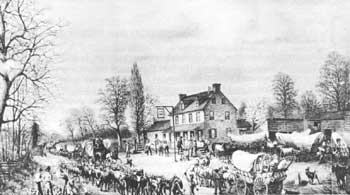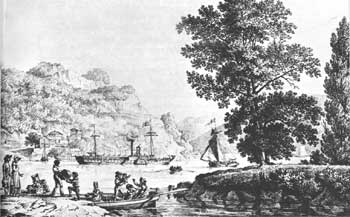





Historical Background
Toward the Setting Sun—The Westward Movement, 1783-1828 (continued)
ROADS AND FARMS—CIVILIZING THE OLD WEST
The second major wave of westward emigration, a surge of nationalism, and unprecedented economic growth marked the period 1815-28. In the years between the end of the War of 1812 and the election of Jackson, settlement moved across the Mississippi and added States to the Union. The new States west of the Appalachians moved toward economic and social maturity and sent national leaders to Congress. By 1828 the political power of the West rivaled that of the older Northeast and South.
"Old America seems to be breaking up and moving westward," wrote Morris Birkbeck, who traveled the National Road in 1817. In 1810 about 1 million people lived in the West. Two decades later 1 million resided in Ohio alone and, according to the 1830 census, 3,672,069 west of the Alleghenies. This figure was about 28 percent of the total population of the United States and almost equal to the total population in 1783. In 1810 Kentucky, Tennessee, and Ohio were the only States west of the Appalachians. By 1830 Mississippi, Indiana, Louisiana, Illinois, Missouri, and Alabama had joined the Union.
 |
| Scene at the Fairview Inn, just outside of Baltimore, along the Frederick Pike, in 1827. The Frederick Pike ran from Baltimore to Cumberland. Inns provided accommodations for turnpike travelers. From a watercolor by Thomas Ruckle. Courtesy, Maryland Historical Society. |
Many factors helped to bring about this transformation. After the war, rapid economic changes—industrialization and sheep raising in New England and the revitalized plantation system in the South—drove many small farmers to seek virgin lands. Improved transportation facilities made the journey easier. The Indian menace seemed less frightening after Harrison's and Jackson's victories, and the Army was making its presence felt. Congress authorized a standing Army of 10,000 men and began the construction of a chain of forts in the first tier of States beyond the Mississippi as well as in the Michigan and Wisconsin country.
After the war of 1812, for the first time, the Government embarked on a policy frankly committed to the removal of the Indians from lands that were desired by whites. The settlers' urge to drive the Indians out was not new, but the open Federal commitment to it was. In 1825 President Monroe endorsed removal as a national policy. That same year treaties signed at Prairie du Chien laid the groundwork by dividing the lands of the Indians in the region into tribal areas. This division would facilitate later treaties that would separate the Indians from their lands. In 1827 the Creeks of Georgia were forced to begin migrating from their ancestral lands. In 1830 the removal became official. The Removal Bill of that year authorized the President to relocate Eastern tribes across the Mississippi. The Cherokees, the immediate object of the bill, fought in the courts, but to no avail. In 1834 they were forced to embark on the "Trail of Tears." In the course of time other tribes would have the same experience. The Indian way of life yielded to another.
 |
| West Point about 1810. The remodeled steamboat Clermont, shown in the foreground, is en route from New York to Albany. From a lithograph by F. Berthaux of Dijon. Courtesy, New York Public Library (Phelps Stokes Collection). |
By 1828 major roads and canals linked the growing cities and multiplying farms. Steamboats plied the rivers. Agriculture continued to dominate the Western economy as it dominated the national economy. Corn, wheat, tobacco, cotton, and livestock were major products. Rich deposits of coal and salt provided income for some. As the West matured, grist mills, sawmills, fulling mills, papermills, and linseed oil mills appeared. Meatpacking became an important industry.
The growing West helped to instill the optimism and faith in progress that are characteristics of the people of the United States. It allowed Americans to measure in quantitative terms how their country, population, and economy grew, census by census. In this bright picture of abundance—the coming of civilization and the fulfillment of the hopes of thousands of settlers—are a few dark shadows. The way of life of the Indian was the victim of "progress." So, too, was there tragedy in the stories of the many whose dreams did not find fulfillment in the West and those who died on the journey or in the Indian wars. Few noticed the shadows. For most, they were insignificant in comparison with the substance of abundance. Already, before 1830, the West had proved to be of immense consequence in the history of the United States.
 |
 |
http://www.cr.nps.gov/history/online_books/founders-frontiersmen/intro22.htm
Last Updated: 29-Aug-2005